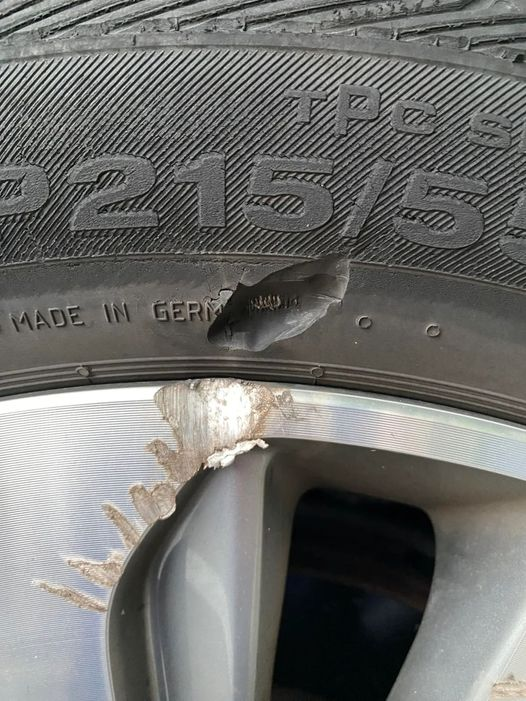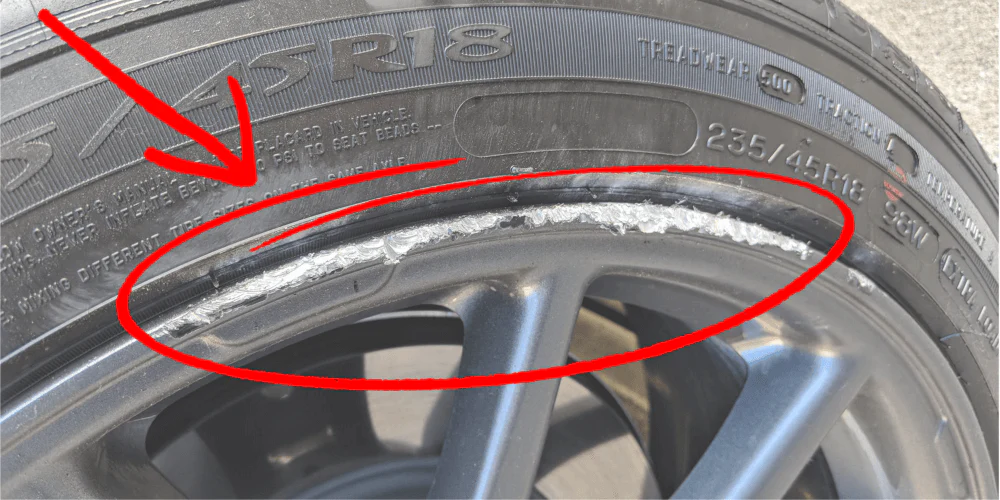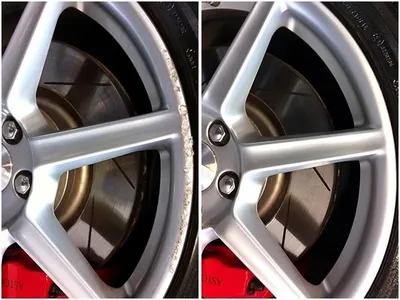Have you just noticed some damage on your girlfriend’s car, specifically on the tire and rim? It looks like there’s a significant cut on the tire’s sidewall, and the rim shows signs of curb rash. If you’re wondering what caused this damage and how to fix it, don’t worry—we’ve got you covered. In this guide, we’ll explore the causes, safety concerns, and possible repair options for these issues.
Why Sidewall Damage is a Major Safety Concern

The sidewall of a tire is one of its most vulnerable parts. Unlike the thicker tread that handles regular wear and tear, the sidewall is thinner and more prone to cuts and punctures. This makes it critical to understand the implications of sidewall damage.
What Causes Sidewall Damage?
Sidewall cuts are often caused by scraping against sharp objects like curbs, pothole edges, or debris. Underinflated tires are especially at risk since they flex more while driving, making them prone to cuts and punctures.
Why Sidewall Damage is Dangerous
A cut in the sidewall isn’t just a cosmetic issue—it can compromise the tire’s structural integrity. Unlike the tread, the sidewall cannot be patched or repaired effectively. Driving with a damaged sidewall increases the risk of a blowout, especially at high speeds. If you notice a deep cut, replacing the tire immediately is the safest option.
Understanding Curb Rash and Its Causes
Curb rash is a common problem for drivers, often resulting from scraping the rim against the edge of a curb. It typically happens while parking or making a tight turn.
Why Rims Get Damaged
Rims can suffer scratches when the tire’s sidewall comes into contact with hard surfaces, such as curbs or potholes. This usually occurs when drivers misjudge their distance from the curb while parking or navigating narrow streets.
Is Curb Rash a Serious Problem?
While curb rash might not pose an immediate safety risk like sidewall damage, it can lead to long-term issues. Deep scratches can weaken the wheel’s structure and potentially cause air leaks by affecting the tire’s ability to maintain a proper seal. If the damage is mostly cosmetic, it can be repaired. However, if there are deep gouges, replacing the rim may be necessary.
Immediate Steps to Take for Tire and Rim Damage
Spotting tire and rim damage can be unsettling, but there are some immediate actions you can take to address the issue:
1. Inspect the Tire Thoroughly
Examine the sidewall damage carefully. If the cut is deep enough to expose internal cords or metal threads, avoid driving any further. Call for a tow truck to take the car to a tire shop for evaluation.
2. Check Tire Pressure
A sidewall cut can cause rapid pressure loss. Use a tire pressure gauge to check if the tire is still holding air. If the pressure is low, inflate it temporarily (if possible) and drive slowly to the nearest service center.
3. Assess the Rim’s Condition
Look closely at the rim for signs of damage. If there are deep gouges, cracks, or bends, consult a professional. Minor scratches can often be fixed by a wheel repair specialist.
Why You Should Replace a Tire with Sidewall Damage

If a tire’s sidewall is compromised, replacing it is the only safe solution. Here’s why driving with a damaged sidewall is not advisable:
1. Sidewall Repairs Are Unreliable
Unlike the tread area, the sidewall cannot be safely patched or plugged. The stresses and flexing on the sidewall are too great for standard repairs.
2. High Blowout Risk
A weakened sidewall is prone to blowouts, particularly at highway speeds where pressure and heat build-up. A blowout can lead to loss of control and potentially cause an accident.
3. Immediate Replacement Required
To ensure safety, replace a tire with sidewall damage as soon as possible. Continuing to drive on it is a serious safety risk.
Repairing Curb Rash: Options and Solutions
Curb rash on rims is usually more of a cosmetic issue, but it can still be addressed if it bothers you or affects the wheel’s functionality. Here are some possible solutions:
1. DIY Repair Kits
Minor curb rash can be treated using DIY repair kits. These kits typically include sandpaper, filler, and paint to restore the rim’s appearance. However, this method is only suitable for surface-level scratches.
2. Professional Rim Repair
For more extensive damage, consider taking the rim to a professional repair service. They use specialized techniques like sanding, buffing, and repainting to restore the rim’s condition.
3. When to Replace the Rim
If the rim is bent, cracked, or has deep gouges, replacing it might be the best course of action. Driving on a damaged rim can affect handling, create vibrations, and damage the new tire.
Could the Damage Indicate a Bigger Issue?

While occasional tire and rim damage can happen to anyone, it’s worth considering if there’s a bigger underlying problem:
Driving Habits
If this isn’t the first time you’ve noticed such damage, it might be time to discuss driving habits with your girlfriend. Repeated sidewall damage and curb rash may indicate a pattern of misjudging curb distances or driving over rough surfaces too quickly.
Alignment and Suspension Problems
Frequent tire damage could also be a sign of misaligned wheels or worn suspension components. It’s wise to have the car inspected to rule out these potential causes.
Parking Challenges
If the car is often parked in tight spaces or along busy streets, it increases the likelihood of rim and sidewall damage. Choosing safer parking spots can help reduce the chances of future incidents.
Conclusion: Prioritize Safety and Repair the Damage
Noticing sidewall cuts and curb rash on a car can be alarming, but addressing these issues promptly is crucial for safety. Sidewall damage requires immediate tire replacement, while curb rash can be repaired or tolerated if it’s only cosmetic. Consider discussing driving habits, alignment checks, and safer parking options to prevent similar damage in the future.
By taking the necessary precautions and repairing the damage promptly, you can ensure a safer and more enjoyable driving experience for your girlfriend, free from the risks of unexpected failures on the road.


